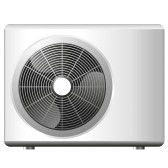 You’ve no doubt noticed that your energy bill goes through the roof in the summer as soon as you turn on your air conditioning. But before you resign yourself to suffering through the sweltering summer heat with nothing more than a dinky table fan and wading pool in the backyard, you might want to figure out just how much electricity your AC unit is actually drawing. This can help you to find ways to use it appropriately for maximum efficiency, energy savings, and a lower utility bill, all while keeping your home relatively cool throughout the summer months. Here’s what you need to do to calculate energy usage for your AC unit.
You’ve no doubt noticed that your energy bill goes through the roof in the summer as soon as you turn on your air conditioning. But before you resign yourself to suffering through the sweltering summer heat with nothing more than a dinky table fan and wading pool in the backyard, you might want to figure out just how much electricity your AC unit is actually drawing. This can help you to find ways to use it appropriately for maximum efficiency, energy savings, and a lower utility bill, all while keeping your home relatively cool throughout the summer months. Here’s what you need to do to calculate energy usage for your AC unit.
First you’ll need to collect a few numbers to plug into your equation, starting with the amount of energy your unit uses per hour. You should be able to find this in the paperwork that accompanies your unit, although it should also be posted somewhere on the unit itself. It will be listed in BTUs, or British thermal units, and this number will tell you the BTUh, or the BTUs the system uses per hour. Next you’ll want to find the SEER (seasonal energy efficiency ratio) rating, which tells you how efficient your air conditioning unit is. And finally, you need to look at your electric bill to find out the rate you pay in kilowatts per hour. Now you’re ready to plug in some numbers.
You’ll start by dividing the BTU by the SEER rating in order to figure out the kilowatts per hour draw for your particular AC unit. Let’s say your unit requires 35,000 BTUh and the SEER rating is 7. Your kilowatts per hour usage would be 5,000 (just for example). Further suppose that your kW/hr cost for energy use is $0.15 (keeping in mind that using more energy could bump you up to a higher payment tier). This would mean you’re paying $7.50 for every hour that you have the air conditioning running. Now all you have to do is keep track of how many hours the system is on within a given billing period and you should be able to calculate your costs for AC usage during the month.
Of course, all things being equal, you could just leave it off one month and then turn it on the next, tracking your hours of usage, to get a rough estimate of what you’re paying per kilowatt hour. Either way, you should know that there are plenty of ways to maintain temperature in order to cut your monthly costs. You might draw the shades, add energy film to your windows, run fans, and program your digital thermostat, for example. And when you know how attic insulation works, you could certainly think about adding materials up top to lessen the impact of the heat overhead.
If you’re really gung-ho, you could even consider installing a geo-exchange to cool your home, although this will cost you a pretty penny up front. The point is that by tracking the amount of energy your AC unit draws, you can come up with other solutions that will help to cut your consumption and your utility bills, all while keeping your home a little cooler. It’s worth doing a little math for the benefits you’ll gain from this knowledge.

No Comments